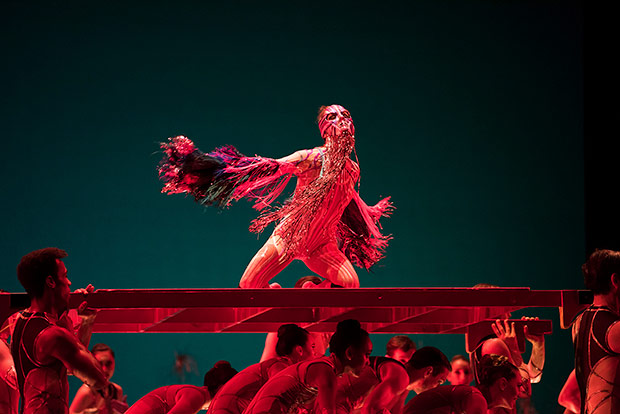
© Erik Tomasson. (Click image for larger version)
San Francisco Ballet
Unbound Festival Program D: The Infinite Ocean, Let’s Begin at the End, Bjork Ballet
★★★★★
San Francisco, War Memorial Opera House
26 April 2018
www.sfballet.org
A hundred monkeys might eventually type out Hamlet, but only a herd of unicorns on Ecstasy could come anywhere near Arthur Pita’s Björk Ballet. As the final world premiere of San Francisco Ballet’s Unbound, the tinsel-fringed, bondage-muzzled, Day-Glo dance brought the festival’s first week to a brilliant – or wretched, depending on whom you ask – conclusion.
The first two works on the Program D triple bill gave no hint of what was in store. Edwaard Liang’s The Infinite Ocean and Dwight Rhoden’s Let’s Begin at the End are conventional contemporary ballets, which is not to say they are by any means average. Each creates a movement languages rich in neologisms, and both exemplify choreographers who view dancers’ technical bents, native musicality and daring as qualities to explore and enhance, rather than as quirks that must be brought to heel.

© Erik Tomasson. (Click image for larger version)
Inspired by the untimely deaths of his father and several friends, The Infinite Ocean is Liang’s meditation on loss and the longing for reconnection, set to an original orchestral score by Oliver Davis. Before her passing, one of his friends said that she would “see you on the other side of the infinite ocean.”
A dozen dancers gathered under the glow of a projected sun, based on Olafur Eliasson’s 2003 light installation at London’s Tate Modern, then disperse into vignettes. Inversions, pirouettes and echappés abound, but movement is the means of an unspoken conversation between human beings.

© Erik Tomasson. (Click image for larger version)
Ghostly under a spotlight, Sofiane Sylve and Tiit Helimets entwine and separate, forging the intimacy that is essential to life but always, inevitably lost. He pulls her along the floor between his feet and she arches over his body; later, Julia Rowe gets thrown in a fully arched layout. The audience gasped, yet there’s nothing showy about tricks like these; they flow from one dancer to another.

© Erik Tomasson. (Click image for larger version)
In another duet, Vitor Luiz lifts Yuan Yuan Tan through cartwheels into finale and arabesques that merge his gallant strength with her liquid grace. Liang followed that with a pat ending that had the dancers leaping backward off the raked set with smiley-faced sanguinity; it felt like pulling a punch.
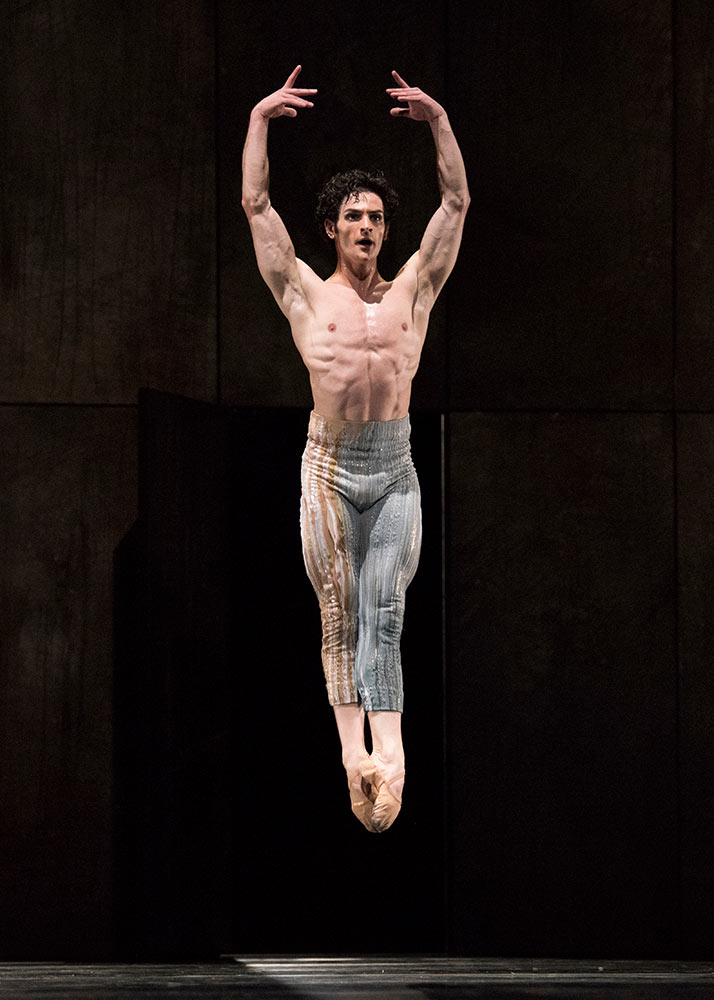
© Erik Tomasson. (Click image for larger version)
Rhoden brought Let’s Begin at the End to a tantalizingly incomplete conclusion as Frances Chung simply walked away from a distressed Angelo Greco, as though in the middle of an argument that will never be resolved. The previous 30 minutes was an infinity loop comprising Chung and Greco, Sasha De Sola and Benjamin Freemantle, and Ulrik Birkkjaer and Jennifer Stahl, who evoked varying states of (dis)harmony.
Rhoden continuously united and separated them, forbidding them from occupying any one state more than fleetingly. Stahl’s arabesque turn floated inside the halo of Birkkjaer’s arms before he lifted and upturned her. De Sola and Freemantle – one of the festival’s breakout stars, and recently elevated from corps to soloist – skimmed each other like swallows in flight. Esteban Hernandez wended in and out in urgent solos, serving as a free radical that destabilized the bonded partners. The allemande from Bach’s Partita No. 2 in D Minor – played spectacularly by Mariya Borozina – plus Philip Glass etudes and Michael Nyman’s “Love Doesn’t End” swirled in the ballet’s turbulent current.

© Erik Tomasson. (Click image for larger version)
Björk Ballet was the eleven o’clock number that jolted the house awake. As Martin West led the orchestra in the Icelandic musician’s “Overture” (the ballet is the first time Björk has allowed her music to be used in this way), metallic grasses dangle from the flys and Maria Kochetkova crawled in wearing a tinsel-goateed mask, fuchsia-pink knee socks and a silver-sequined tunic. The weighted grass stalks fell to the stage, and the 22-dancer cast broke into a simulation of free love among the bulrushes.

© Erik Tomasson. (Click image for larger version)
Pita and fashion designer Marco Morante created a visual whirlwind, and there’s no keeping up. Dores André and Luke Ingham’s frozen-time duet gave way to ensemble men in bi-color harem pants; Kochetkova returned in riotously fringed sleeves, carried on a bier; Sarah Van Patten changes into an Argentine tango dress composed of nude mesh, trailing red chiffon and a few strategically crisscrossed sequined ribbons; as her partner, Birkkjaer didn’t even get the chiffon.
Many dancers are anonymized by sequined muzzles, masks and crown-to-tiptoe unitards. A squadron of silver-and-charcoal snowflakes danced to the jingle-bells of Björk’s song “Frosti.” Wei Wang hid behind happy and sad masks while wandering through the tableaux as a pensive fisherman; in his final solo to “Anchor Ballad,” Björk promised that he, and we, will all find love.

© Erik Tomasson. (Click image for larger version)
It’s not hard to imagine how polarizing a work like Björk Ballet could be, and was. It offended some passionate Björk fans, while other people stood up and cheered. Even Liaang and Rhoden’s tamer pieces had admirers as well as detractors who called this or that artistic choice into question. The triumph of the Unbound Festival has not been the creation of twelve perfect new works, but in getting people to care enough about ballet, music and art to take a stand.














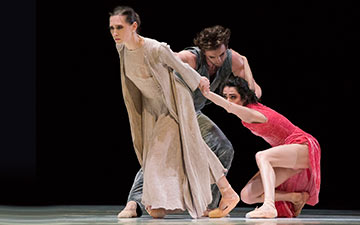
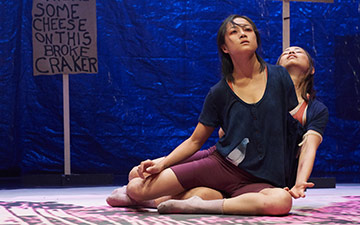
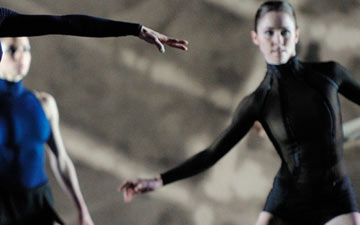
You must be logged in to post a comment.